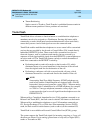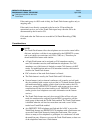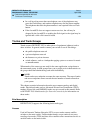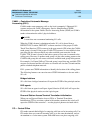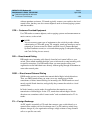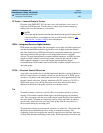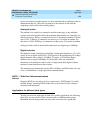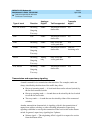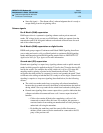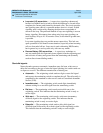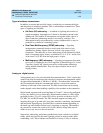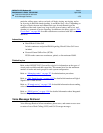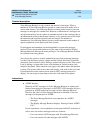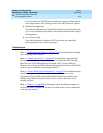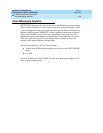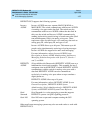
DEFINITY ECS Release 8.2
Administrator’s Guide
555-233-506
Issue 1
April 2000
Features and technical reference
1570Trunks and Trunk Groups
20
■ Start-dial signal — The distant office’s acknowledgment that it is ready to
accept dialing from the originating office.
Seizure signals
Ear & Mouth (E&M) supervision
E&M supervision is a symmetric signaling scheme used on private network
trunks. DC voltage levels are sent over E&M leads, which are separate from the
transmission path. E & M signals indicate on-hook and off-hook states for each
end of the connection path.
Ear & Mouth (E&M) supervision on digital trunks
DIOD trunk groups support Continuous and Pulsed E&M Signaling that allows
you to make and receive calls over Brazil pulsed or continuous E&M signaling
trunks and Hungarian pulsed E&M signaling trunks. Refer to DEFINITY ECS
Application Notes for Type Approval for more information.
Ground-start (GS) supervision
Ground-start signaling is a supervisory signaling scheme used on public network
trunks in which ground is applied on the tip (T) lead by the CO and on the ring (R)
lead by the switch. For example, the calling switch on a call to a CO seizes the
outgoing trunk by placing a ground on the trunk interface R lead. The CO
recognizes the trunk seizure as a request for service and grounds the trunk T lead
to indicate to the calling switch that the CO is ready to receive digits. Ground-start
signaling is superior to loop-start signaling (described below) for the following
reasons:
■ The switch can make trunks busy to outgoing calls almost immediately,
because the tip ground seizure by the distant switch minimizes the interval
during which a two-way trunk can be seized from both ends (called glare).
■ Ground-start signaling allows answer supervision, a positive indication that
a distant switch has disconnected from a call. Answer supervision has 2
benefits:
— Callers who remain off-hook after completing a call won’t be
connected to central office dial tone. For example, this prevents a
restricted station from making an unauthorized call after placing an
authorized call using the attendant.
— By holding the trunk busy until the central office disconnects,
another switch cannot seize the trunk and be connected to the CO
party of the previous call.



